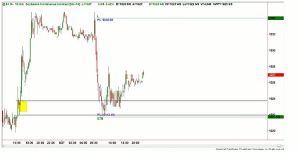How is it even possible to trade without human emotion getting in the way? This is the one question that seems to consistently plague a lot of traders, but Gabe Velazquez of Online Trading Academy thinks that it can be done and maps out the way to do it.
Is it possible to trade without emotion? I believe so, however, it will take plenty of work to get there. We all know that the financial markets largely operate on the emotions of fear and greed, and that markets move on the collective perceptions of those that participate in them. As traders we must learn to identify what fear and greed looks like on a price chart, so that we can capitalize on the weaknesses of other traders. It may sound crass to say that, but that’s the reality of speculating in the financial markets.
So what if you can’t see the emotions of fear and greed on a price chart, and you personally wrestle with these emotions in your own trading? If this sounds like you, and you react impulsively to every movement in the market, it tells me that you probably don’t have a sound set of rules that govern your actions when trading. It seems then, that one way to begin controlling emotions is by learning a proven strategy that has a simple way to identify entry and exit points. Once that work is done then the most challenging aspect of trading begins, that is the discipline to follow the rules and not let emotions interfere with the system.
At Online Trading Academy we teach people to set the entry stop and target all at once and then leave the trade to play out. We call this “set and forget” because that’s exactly what it means, forget it and get comfortable with the outcome. This way of doing trades serves to take the emotion out of trading. This is very important as emotions are a trader’s worst enemy. It seems easy enough, but for the average trader this is quite difficult. That’s simply because most traders are emotionally attached to the outcome of each trade. Getting around this issue requires a rewiring of the brain to think in terms of probabilities, risk, and reward.
On Wednesday of last week, I was in a session with some our students, having a discussion about this very topic. I showed a trade that I was in—the Soy Bean market—and was already about one quarter of the way to my profit target.
In the chart above, we can see the risk on the trade is $112.50 and the reward is $500.00. The profit target is not an arbitrary number but rather a strategic area where sellers have been present in the past.
If we leave the trade alone there are only two possible outcomes: a loss of $112.50 or the profit $500 will be achieved. If a trader is only right 50% of time and has the discipline to achieve these types of risk-to reward ratios, how do you think she will do? The answer is very good.
Yes, we could trail the stop and make many adjustments along the way but that gets us emotionally involved in the trade. Think about how many trades in your past would have worked if you had just left them alone.
In the final analysis, how this trades ends up is of little consequence in the big picture scheme of things, that is only if, the losses are small, the reward is high and the probabilities are higher than average (having an edge).
By Gabe Velazquez, Instructor, Online Trading Academy






















